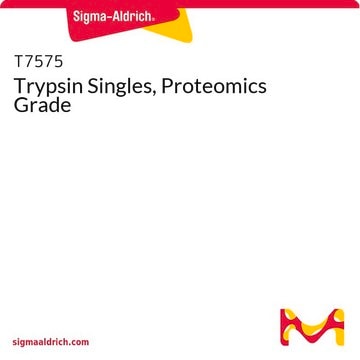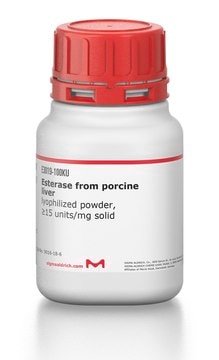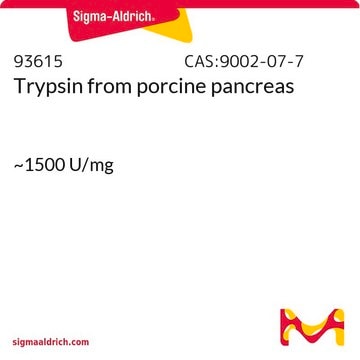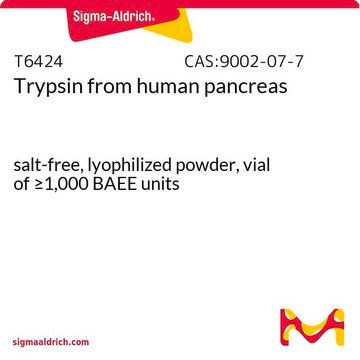This product is soluble in 1mM HCL.
T6567
Tripsina
Proteomics Grade, BioReagent, Dimethylated
Sinonimo/i:
Porcine Trypsin, Trypsin for Mass Spectropetry
Scegli un formato
Scegli un formato
About This Item
Prodotti consigliati
Origine biologica
Porcine pancreas
Livello qualitativo
Nome Commerciale
BioReagent
Solubilità
1 mM HCl: soluble 1 mg/mL, clear, colorless
Condizioni di spedizione
wet ice
Temperatura di conservazione
2-8°C
Descrizione generale
Applicazioni
- Digestione in gel delle proteine e analisi con spettrometria di massa MALDI-TOF[3]
- Analisi con spettrometria di massa con ionizzazione per elettronebulizzazione (ESI-MS)[4]
- Profilazione del proteoma di superficie di L. plantarum[5]
- Filtrazione su gel, ultracentrifugazione e microscopia elettronica con rotary shadowing[6]
- Spettrometria di massa[7][8]
Azioni biochim/fisiol
Prodotti correlati
Avvertenze
Danger
Indicazioni di pericolo
Consigli di prudenza
Classi di pericolo
Eye Irrit. 2 - Resp. Sens. 1 - Skin Irrit. 2 - STOT SE 3
Organi bersaglio
Respiratory system
Codice della classe di stoccaggio
11 - Combustible Solids
Classe di pericolosità dell'acqua (WGK)
WGK 1
Dispositivi di protezione individuale
dust mask type N95 (US), Eyeshields, Faceshields, Gloves
Scegli una delle versioni più recenti:
Certificati d'analisi (COA)
Non trovi la versione di tuo interesse?
Se hai bisogno di una versione specifica, puoi cercare il certificato tramite il numero di lotto.
Possiedi già questo prodotto?
I documenti relativi ai prodotti acquistati recentemente sono disponibili nell’Archivio dei documenti.
I clienti hanno visto anche
Articoli
Evaluation of Recombinant, Chemically Treated Trypsin in Proteomics and Protein Characterization Assays
Get better detection and quantification of proteases with this high-sensitivity red protease detection assay.
Pretreatment with Mucinase StcE increases glycopeptide identification from mucin samples, enhancing sample preparation efficiency for glycopeptide analysis.
The field of proteomics is continually looking for new ways to investigate protein dynamics within complex biological samples. Recently, many researchers have begun to use RNA interference (RNAi) as a method of manipulating protein levels within their samples, but the ability to accurately determine these protein amounts remains a challenge. Fortunately, over the past decade, the field of proteomics has witnessed significant advances in the area of mass spectrometry. These advances, both in instrumentation and methodology, are providing researchers with sensitive assays for both identification and quantification of proteins within complex samples. This discussion will highlight some of these methodologies, namely the use of Multiple Reaction Monitoring (MRM) and Protein-AQUA.
Protocolli
Continuous spectrophotometric rate determination method using BAEE substrate measures trypsin activity, essential for enzyme characterization.
-
What can I use to solubilize this Product T6567, Trypsin from porcine pancreas?
1 risposta-
Utile?
-
-
How can we digest protein using Product T6567, Trypsin from porcine pancreas?
1 risposta-
As per Sigma R and D the information is as follows: In order to efficiently digest a protein with trypsin, it must be denatured and the disulfide bonds modified by reduction and alkylation, or at least reduced. Many intact proteins are highly resistant to digestion with trypsin. If you do not want to reduce and alkylate, you can then just boil the protein with 5 mM DTT or 20 mM 2ME for 10 minutes, and then quickly cool on ice to denature the protein. This may result in a precipitate, but the trypsin will still digest the protein and it will clear within an hour or two. You can also dissolve the protein in 6 M guanidine-HCl or 8 M urea. Reduce and alkylate using the PROT-RA kit or other suitable method. Then they would have to dilute the solution to less than 2 M of either denaturant and then add the trypsin. This is the method that we use routinely in the lab.
Utile?
-
-
What is the Department of Transportation shipping information for this product?
1 risposta-
Transportation information can be found in Section 14 of the product's (M)SDS.To access the shipping information for this material, use the link on the product detail page for the product.
Utile?
-
-
Is Product T6567, Trypsin from porcine pancreas, TPCK treated?
1 risposta-
The product has been treated with TPCK to remove chymotryptic activity, further purified through affinity chromatography, and lyophilized, resulting in convenient use and highly specific cleavage. This information is on the product page under application.
Utile?
-
-
What is the package size of Product T6567, Trypsin from porcine pancreas?
1 risposta-
Each vial content 20 ug of the product.
Utile?
-
-
How can we get Trypsin sequence information for Product T6567, Trypsin from porcine pancreas?
1 risposta-
If you are looking for trypsin sequence information, you have to go to the NCBI Protein Data Bank.
Utile?
-
Filtri attivi
Il team dei nostri ricercatori vanta grande esperienza in tutte le aree della ricerca quali Life Science, scienza dei materiali, sintesi chimica, cromatografia, discipline analitiche, ecc..
Contatta l'Assistenza Tecnica.













